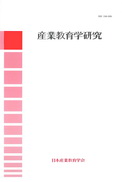Volume 29, Issue 2
Displaying 1-9 of 9 articles from this issue
- |<
- <
- 1
- >
- >|
-
Article type: Article
1999Volume 29Issue 2 Pages 1-10
Published: July 31, 1999
Released on J-STAGE: July 18, 2017
Download PDF (1566K) -
Article type: Article
1999Volume 29Issue 2 Pages 11-19
Published: July 31, 1999
Released on J-STAGE: July 18, 2017
Download PDF (1429K) -
Article type: Article
1999Volume 29Issue 2 Pages 20-27
Published: July 31, 1999
Released on J-STAGE: July 18, 2017
Download PDF (1302K) -
Present Situation and Problems Regarding Full-time Workers' Admission to Part-time Graduate ProgramsArticle type: Article
1999Volume 29Issue 2 Pages 28-35
Published: July 31, 1999
Released on J-STAGE: July 18, 2017
Download PDF (1356K) -
Article type: Article
1999Volume 29Issue 2 Pages 36-42
Published: July 31, 1999
Released on J-STAGE: July 18, 2017
Download PDF (955K) -
Article type: Article
1999Volume 29Issue 2 Pages 43-47
Published: July 31, 1999
Released on J-STAGE: July 18, 2017
Download PDF (887K) -
Article type: Article
1999Volume 29Issue 2 Pages 48-49
Published: July 31, 1999
Released on J-STAGE: July 18, 2017
Download PDF (378K) -
Article type: Article
1999Volume 29Issue 2 Pages 50-
Published: July 31, 1999
Released on J-STAGE: July 18, 2017
Download PDF (195K) -
Article type: Bibliography
1999Volume 29Issue 2 Pages 52-54
Published: July 31, 1999
Released on J-STAGE: July 18, 2017
Download PDF (244K)
- |<
- <
- 1
- >
- >|
